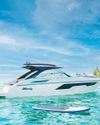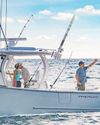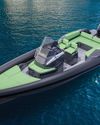Essayer OR - Gratuit
BEFORE YOU CRUISE
Yachting US
|April 2023
Top safety tips for yachtsmen who are heading offshore.

The 30-foot Catalina Atrevida II was not where it was supposed to be. Sixty-four-year-old Kevin Hyde, 76-year-old Joe DiTomasso and his dog Minnie had left Cape May, New Jersey, on November 27 for a cruise to Marathon, Florida. For a while, everything went fine. According to news reports, DiTomasso was known for losing his phone, so his family didn't worry after the men left North Carolina on December 3 and then went silent.
But by December 11, that quiet was deafening. The US Coast Guard Fifth District Command Center in the mid-Atlantic was notified. Rescuers immediately issued urgent alerts and reached out to commercial vessels in the search area. Multiple aircraft and cutters were launched; vessels from the US Navy's Second Fleet started searching.
By the time a tanker crew spotted the Atrevida II more than 200 miles off the Delaware coast, 10 days had passed. The boat was dismasted. The men were exhausted. They had no fuel or power. All their radios and navigation equipment were dead.
What likely saved their lives was the fact that they were waving a green flag-pretty much their only remaining option.
THE HUMAN FACTOR
Kevin Ferrie knows stories like this one all too well. He's a retired US Coast Guard commander who now serves as a civilian with the US Coast Guard Office of Auxiliary Boating & Safety.
"The majority of accidents that are in our database the root cause is human factors. Somebody did something or made a poor judgment call," he says.
Cette histoire est tirée de l'édition April 2023 de Yachting US.
Abonnez-vous à Magzter GOLD pour accéder à des milliers d'histoires premium sélectionnées et à plus de 9 000 magazines et journaux.
Déjà abonné ? Se connecter
PLUS D'HISTOIRES DE Yachting US

Yachting US
QUEEN FOR A DAY
Positioned off the coast of British Columbia, Canada, Haida Gwaii proves to be an intoxicating waypoint.
2 mins
December 2023

Yachting US
"In the World of Yachting" - 1926
In 1925, Chapman helped run the double-ended Rainbow IV 1,215 miles in a 24-hour endurance race, setting a record.
1 min
December 2023

Yachting US
CARIBBEAN FUN TIMES TWO
No need to pick sides. There's plenty to enjoy in both Saint-Martin and St. Maarten.
2 mins
December 2023

Yachting US
TURNING TIDES
The Icon blends BMW's luxury design and Tyde's sustainable propulsion.
1 min
December 2023

Yachting US
STAR LIGHT, DATA BRIGHT
Starlink is making it easier and less expensive for boaters to stay better connected in countless locations.
4 mins
December 2023

Yachting US
FAMILY-FRIENDLY
Windy Boats'40 Camira RS packs a lot of features across its 40-foot length.
2 mins
December 2023

Yachting US
AN EVEN BETTER VIEW
Garmin's GMR xHD3 open-array radars give skippers a clearer picture of what's all around the boat.
1 mins
December 2023

Yachting US
SUN RUNNER
Lomac's Turismo 9.5 has bold aesthetics, strong performance and major practicality.
1 min
December 2023

Yachting US
EVERYDAY ESCAPES
Yacht owners rarely need to cruise far for a relaxing change of scenery and a memorable getaway.
2 mins
December 2023

Yachting US
SUBTLY SWEET
WITHIN ITS STRIKING EXTERIOR LINES, THE FAIRLINE PHANTOM 65 IS A SPORT-BRIDGE YACHT WITH MANY COMFORTS.
3 mins
December 2023
Translate
Change font size
